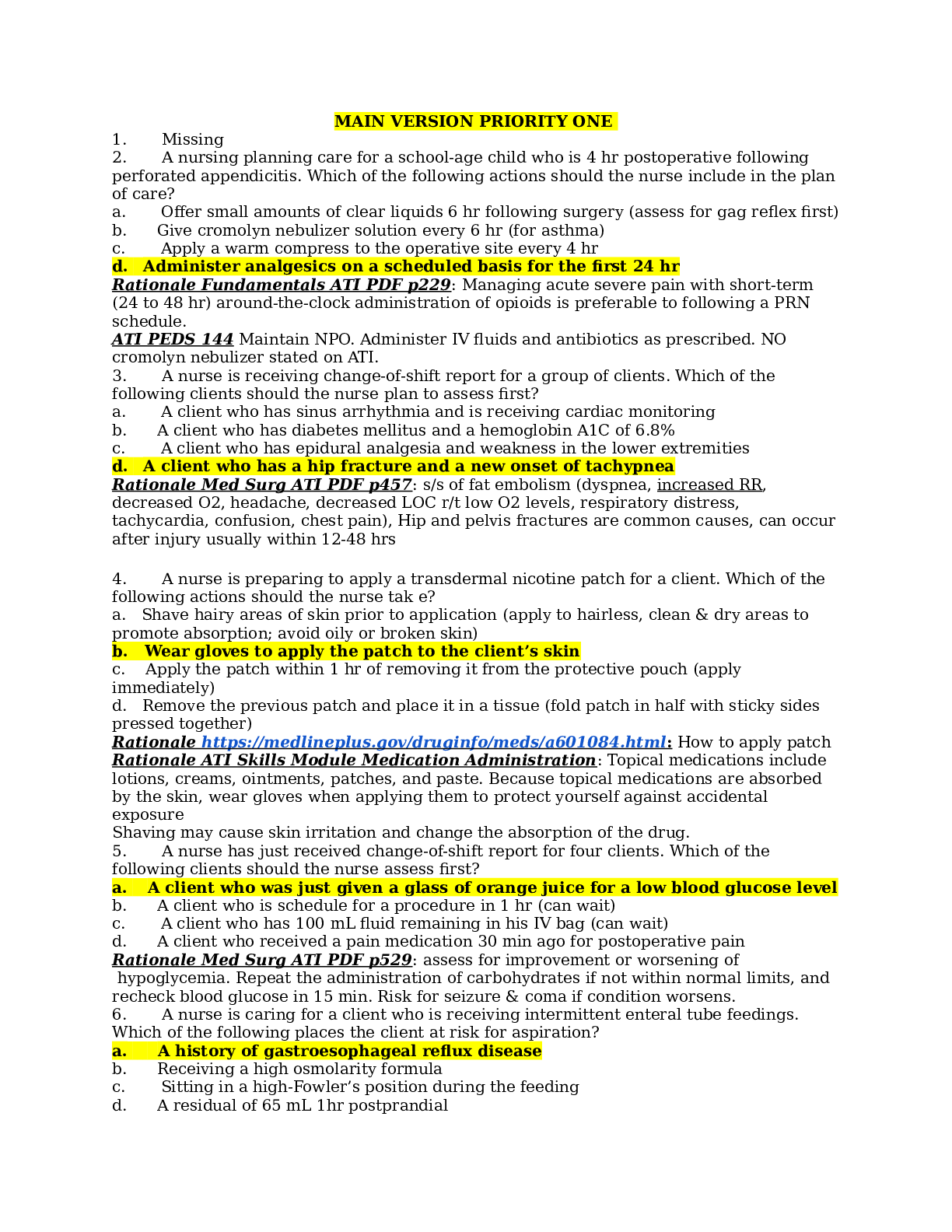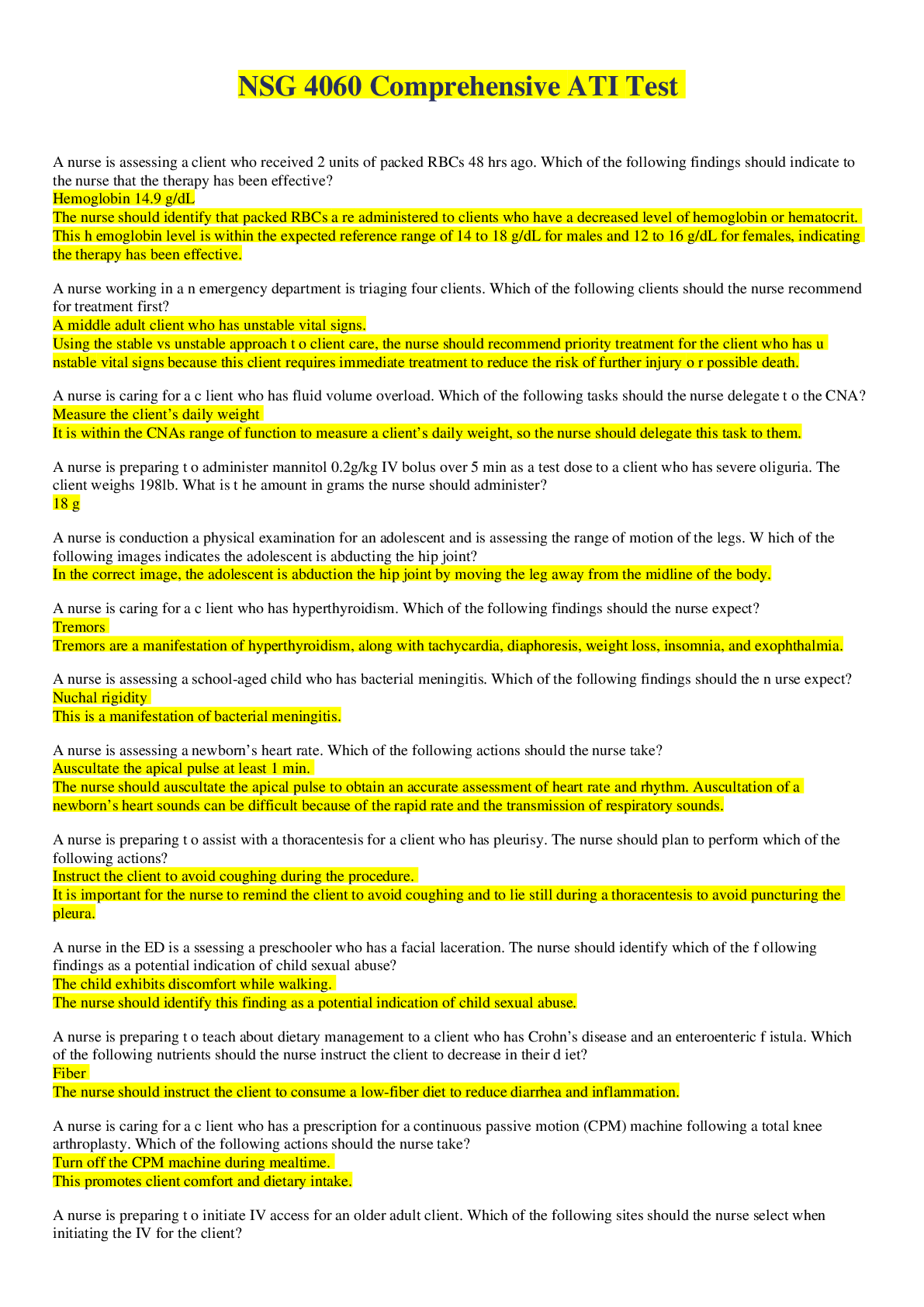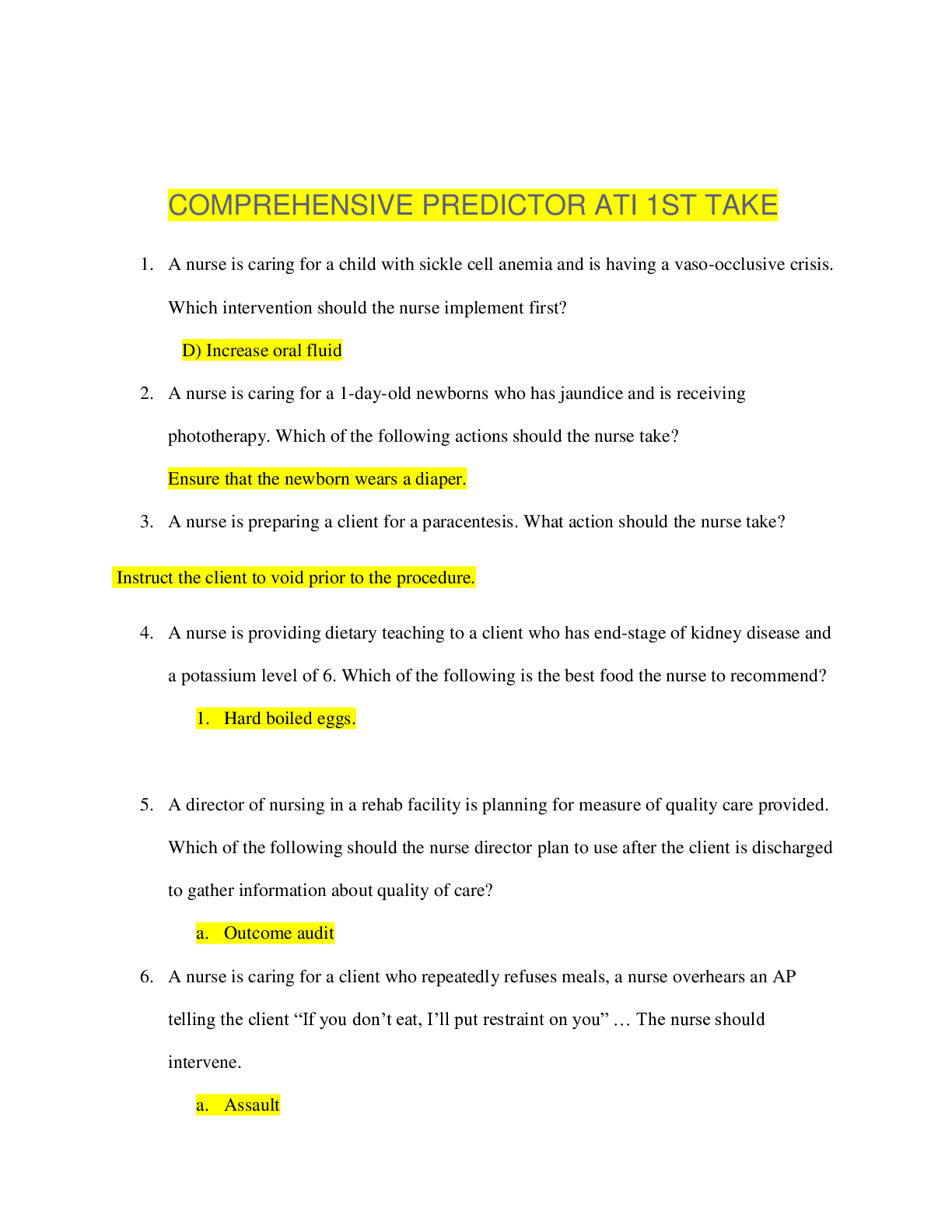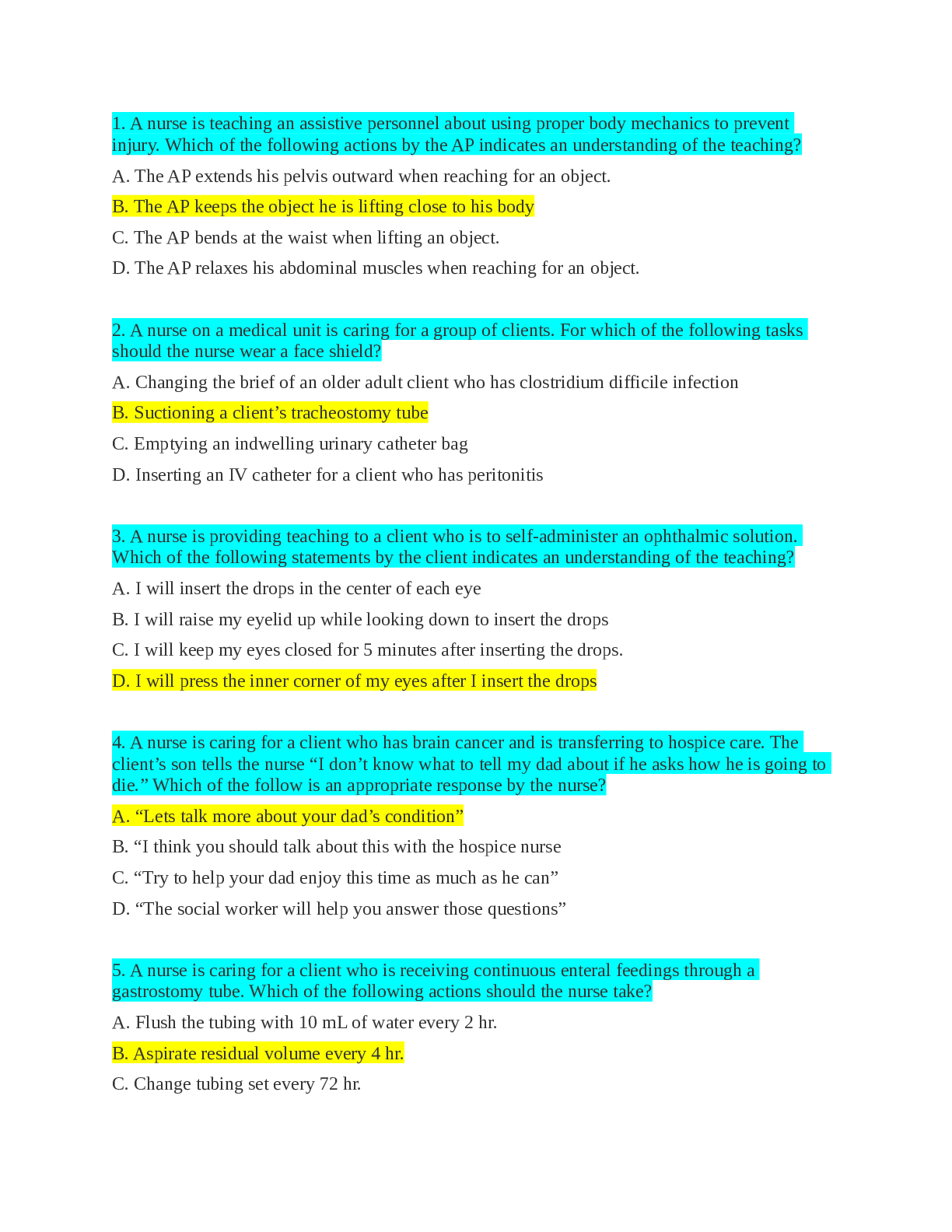*NURSING > QUESTIONS and ANSWERS > Fundamentals ATI – Physical Assessment – Adult (All)
Fundamentals ATI – Physical Assessment – Adult
Document Content and Description Below
1. What is your primary goal in performing a comprehensive physical assessment? a. To document accurate data b. To develop a plan of care c. To validate previous data d. To evaluate outcomes of ca... re Rationale: Remember the nursing process: assessment, diagnosis, planning, implementation, evaluation. Assessment is the first part of the process. It generates the database from which you will make nursing decisions. Your objective in interacting with patients is to identify their needs and concerns and help find solutions. That is the nursing process in action – and your map is the nursing care plan you establish for each patient. Analyzing and synthesizing data will provide the basis for each nursing diagnosis and for the selection of nursing interventions to manage actual or potential health problems. 2. While performing a cardiovascular assessment, you might encounter a variety of pulsations and sounds. Which of the following findings is considered normal? a. A continuous sensation of vibration felt over the second and third left intercostal spaces b. A high-pitched, scraping sound heard in the third intercostal space to the left of the sternum c. A brief thump felt near the fourth or fifth intercostal space near the left midclavicular line d. A whooshing or swishing sound over the second intercostal space along the left sternal border Rationale: This is where you would inspect and palpate for the point of maximal impulse. Also called an apical pulsation, it occurs as the apex of the heart bumps against the chest wall with each heartbeat. The apical impulse is not always visible but can be felt as a brief thump. This is a normal and expected finding when you are preparing to auscultate an apical pulse. 3. While examining your patient’s head and face, you determine that cranial nerve I is intact when the patient follows your instructions and successfully a. Sticks his tongue out. b. Smiles symmetrically. c. Hears whispered words. d. Identifies a minty scent. Rationale: Cranial nerve I, the olfactory nerve, controls the sense of smell. To test this nerve’s function, ask the patient to identify a nonirritating aroma, such as mint or coffee. 4. Over which abdominal quadrant are bowel sounds most active and therefore easiest to auscultate? a. Right upper quadrant b. Left upper quadrant c. Right lower quadrant d. Left lower quadrant Rationale: To the right of the umbilicus in the right lower quadrant is the ileocecal valve. This is where the small intestine connects to the large intestine, and it is normally very active with bowel sounds. Many nurses begin listening here for that reason. For the average adult, you’ll hear five to 30 bowel sounds per minute. 5. When performing a complete, head-to-toe examination, which physical-assessment technique should you perform first? a. Auscultation b. Inspection c. Percussion d. Palpation Rationale: Inspection is the process of observation. You will first inspect the body systematically, observing for normal as well as abnormal physical signs. When assessing most body systems, the recommended order is inspection, palpation, percussion, and auscultation. Abdominal assessment is an exception, since any manipulation of or pressure on the abdomen may stimulate peristalsis, the waves of contraction that propel contents through the gastrointestinal tract, and thus alter the patient’s bowl sounds. So, when assessing the abdomen, inspection is still first, but auscultation comes before percussion and palpation. 6. When using and maintaining your stethoscope, it is important to a. Insert the earpieces at an angle toward your nose. b. Use the diaphragm for listening to low-pitched sounds. c. Drape the stethoscope over your neck when not in use. d. Clean your stethoscope by immersing it in soapy water. Rationale: Angling the earpieces toward your nose helps ensure that sounds are effectively transmitted to your eardrums. 7. You are performing a physical examination of the spine for an older adult. Which of the following findings is common with aging? a. Lordosis b. Kyphosis c. Ankylosis d. Scoliosis Rationale: Kyphosis, a pronounced “hunchback” curvature of the spine, is an abnormal angulation of the posterior curve of the thoracic spine, usually a result of osteoporosis. It is most common in older adults and tends to increase with aging. This pronounced convexity of the thoracic spine is also common in older patients who have had vertebral fractures. 8. When assessing peripheral vascular status of the lower extremities, you place your fingertips on the top of your patient’s foot between the extensor tendons of the great toe and those of the toe next to it. Which pulse are you palpating? a. Posterior tibial b. Popliteal c. Dorsalis pedis d. Femoral Rationale: In the lower extremities, the most common pulse tested is the dorsal pedis pulse, found on the dorsum of the foot between the extensor tendons to the great toe and the toe next to it. 9. When performing a respiratory assessment, you auscultate wet, popping sounds at the inspiratory phase of each respiratory cycle. These sounds are best identified as a. Crackles. b. Stridor. c. Wheezes. d. Friction rub. Rationale: Crackles, which are sometimes called rales, are wet, popping sounds created by air moving through liquid or by collapsed alveoli snapping open on inspiration. They are most common at the end of inspiration. 10. While performing an abdominal assessment, you place your fingertips over the patient’s painful area and gradually increase pressure, then quickly release it. The patient reports increased pain on release of pressure, so you document that your patient has positive a. Borborygmi. b. Rebound tenderness. c. Tympany. d. Abdominal guarding. Rationale: This procedure elicits rebound tenderness – an increase in pain when deep palpation over a tender area is released. Rebound tenderness in the right lower quadrant at McBurney’s point (one third the distance from the anterior iliac crest to the umbilicus) is a sign of acute appendicitis. 11. While performing a head-to-toe assessment, you perform the Romberg test. You do this to test the patient’s a. Gait. b. Hearing. c. Vision. d. Balance. Rationale: The most common test of balance is the Romberg test. Ask the patient to stand about 2 feet in front of you, with her feet together, toes pointed forward, and her hands at her sides. While you extend your hands so that one is on either side of the patient, ask her to close her eyes. Watch to see how well she can maintain balance in that position. A minimum of swaying is normal. But if the patient sways more than a couple of inches, stop the test and document that the patient demonstrated difficulty maintaining balance on Romberg testing. 12. As part of your general patient survey, you find that your patient has a body mass index (BMI) of 23. From this finding, you can conclude that your patient a. Has no nutritional problems or deficits. b. Is at high risk for obesity-related health problems. c. Needs a referral to a nutritional counselor. d. Has a body mass index within normal limits. Rationale: BMI is a measurement of an adult’s body fat based on height and weight. Generally, a BMI between 18.5 and 24.9 reflects a normal weight with a normal amount of body fat. A patient with a BMI below 18.5 is considered underweight; a patient with a BMI of 25 or above is considered overweight; and one with a BMI of 30 or above is considered obese. [Show More]
Last updated: 2 years ago
Preview 1 out of 4 pages
.png)
Buy this document to get the full access instantly
Instant Download Access after purchase
Buy NowInstant download
We Accept:

Reviews( 0 )
$10.00
Can't find what you want? Try our AI powered Search
Document information
Connected school, study & course
About the document
Uploaded On
Sep 18, 2020
Number of pages
4
Written in
Additional information
This document has been written for:
Uploaded
Sep 18, 2020
Downloads
0
Views
77













.png)

